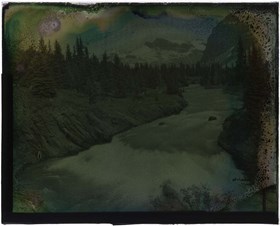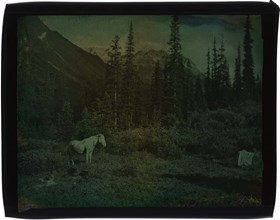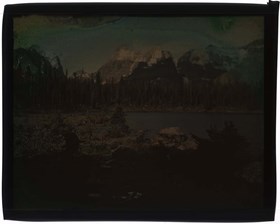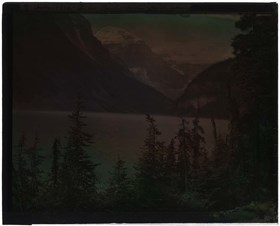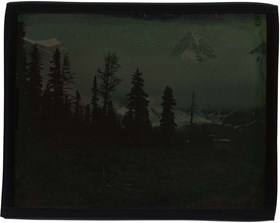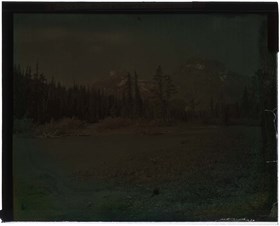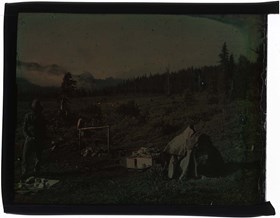Narrow Results By
Lantern Slides
https://archives.whyte.org/en/permalink/descriptions54147
- Part Of
- Stan J. Carr fonds
- Scope & Content
- File consists of 8 colour lantern slides, some captioned. File subjects include an unidentified mountain scene, Mount Assiniboine, horse in unientified mountain scene, man posed in campsite in unidentified location, Lake Louise and Victoria Glacier, Hector Lake and Bow Peak, unidentified man in cam…
- Date Range
- ca. 1912
- Reference Code
- V127 / PS - 1 to 8
- Description Level
- 5 / File
- GMD
- Transparency
- Lantern slide
8 images
- Part Of
- Stan J. Carr fonds
- Description Level
- 5 / File
- Fonds Number
- M 179
- V 127
- Sous-Fonds
- V 127
- Accession Number
- 1072
- Reference Code
- V127 / PS - 1 to 8
- Date Range
- ca. 1912
- Physical Description
- 8 photographs : col. slides ; 10.5 x 14 cm
- History / Biographical
- Additive Colour Screen Plates, first theorized by James Clerk Maxwell in 1861, were the first forms of colour photography. Maxwell’s original process involved printing the same black and white image through different coloured screens onto transparencies and then projecting them overlapped in order to create a single full-colour image. In 1868 Louis Ducos du Hauron expanded on this method by placing a screen made up of microscopic coloured stripes in front of a light-sensitive emulsion before exposing it to light. During exposure, the colours in the screen attached to the developing picture so when viewed back through the screen in a projector the image appeared fully in colour. Neither of these methods were commercially popular during the 19th century since black and white processes were cheaper and more widely available. In 1907 the Lumiere brothers introduced the Autochrome process to wide commercial success. The Autochrome process involved a mix of tiny potato starch grains dyed green, orange-red, and blue-purple that were mixed thoroughly and applied to a glass slide coated in a sticky varnish that held the grains in an evenly-distributed layer. The grains were laminated into the varnish to make them smaller and more transparent, and then the whole thing was sealed with another layer of waterproof varnish. The entire process could be done by machines, which made the slides cheap to produce, easily available to the public and opened up the process to amateur photographers. Photographs developed on Autochrome plates created soft images with relatively natural colour rendering, making them popular with artists and photojournalists. Autochrome plates (which came to refer to all colour screen plates regardless of manufacturer) created one-of-a-kind positive images and required long exposure times. Once an image was complete, it had to be quickly covered with either a strong coating of varnish or another slide of glass and then sealed along the edges with binding tape. Because silver is an element of the sticky base varnish that holds the dyed grains, if moisture was allowed to access the image the layers of varnish could ripple or tear away from the glass, or the dye could bleed or fade. The silver base is highly sensative to oxygen and if improperly sealed images could begin to "mirror," a process in which the exposed parts of the slide become uniform and shiny, obscuring the image. Because of the random distribution of dyed colour grains throughout the image and the lines created by laminating those grains into the base varnish, Autochrome transparencies are often mistaken for hand-painted coloured slides. Autochrome can be identified by looking closely for small dots of colour in all parts of the image, rather than the solid blots of colour found on hand-painted slides.
- Scope & Content
- File consists of 8 colour lantern slides, some captioned. File subjects include an unidentified mountain scene, Mount Assiniboine, horse in unientified mountain scene, man posed in campsite in unidentified location, Lake Louise and Victoria Glacier, Hector Lake and Bow Peak, unidentified man in camp.
- Name Access
- Carr, Stan J.
- Subject Access
- Exploration
- Discovery and travel
- Lantern slide
- Geographic Access
- Mount Assiniboine
- Lake Louise
- Bow Summit
- Banff National Park
- Alberta
- Canada
- Access Restrictions
- No restrictions on access
- Language
- English
- Conservation
- Re-seal all slides appropriately; keep stored in cool, dry, dark area; refrain from exposing to further damage.
- Creator
- Carr, Stan J.
- Category
- Exploration, discovery and travel
- Biographical Source Notes
- http://www.graphicsatlas.org/identification/?process_id=286#overview
- https://psap.library.illinois.edu/collection-id-guide/slide#autochrome
- Title Source
- Title based on contents of file
- Processing Status
- Processed
Images
This material is presented as originally created; it may contain outdated cultural descriptions and
potentially offensive content.
Read more.

